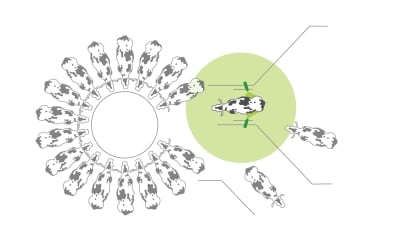According to Ellinor Eineren, founder of Agricam, the average European dairy farmer is losing approximately €20,000-60,000 ($22,500-$67,000) each year due to mastitis.
Mastitis is a disease that affects the mammary gland and udder tissue of lactating animals. It usually occurs in response to an invasion of bacteria in the teat canal, which can be transmitted from bacterial sources on the farm. These include soil bacteria (which are washed into water during heavy rain) and bacteria in polluted waters.
The disease can also be caused by a mechanical, chemical or thermal injury to the cow’s udder. Thermal imaging technology can detect the early signs of the disease, allowing farmers to prevent the disease naturally rather than resort to antibiotics.
Use of thermal imaging
Thermal imagers, (also known as thermal imaging cameras or infrared cameras) are sensing devices that display a visual representation of infrared energy emitted by living beings or objects.
Those viewing the thermal images can immediately spot any anomalies or irregular distributions, which, depending on the context can have various implications.
Diagnosticians can use these cameras to help act on these issues before they have a chance of worsening.
Equine clinics in the US have reported that thermal imaging technology can detect fluctuations in the circulation of large and small animals, which Clark Equine Clinic, Albion, Idaho, states can be confirmed at an earlier stage than by using ultrasounds.
Early detection of mastitis
AgriCam CaDDi Mastitis is a thermal imaging system that permits the early detection of mastitis. The system provides a visual representation or ‘heat-map’ of the animal’s body, and can show a real-time distribution of the heat.
Agricam’s product can be used as a diagnostic tool in order to identity any anomalies in an animal’s overall temperature. This is useful for identifying mastitis, because one of the symptoms of the disease can be a rise in temperature in the udder.
Higher temperatures do not always equate to clinical mastitis but farmers will usually have the knowhow to know the distinction between severe and benign inflammation.
How it works
The non-invasive thermal imaging cameras are placed at the entrance of the parlor, and capture an animal’s ‘thermal image’ when it enters the area.

The animal needs to be between 0.5 and 5 meters from the camera for the device to capture a precise image; no contact is needed. As the cow passes through the camera station images are stored in the database of the system.
Thermal images are collected for each cow that passes the camera so the computer can distinguish between "normal" readings and any anomalies.
Livestock do not need to be stopped and held still to be monitored. This encourages productivity and doesn’t halt the daily routine of herding and production.
Computer analysis of data
Images collected by the cameras are automatically analyzed by computer software that uses algorithms to identify temperature fluctuation. If any disease or any anomalies are detected, the software will notify the farmer.
When the disease is detected, the infected cow will be milked more frequently in order to maintain minimal milk in the udder. Less milk in the udder means less substance for bacteria to use.
This allows the animal’s natural defence system to eradicate the bacteria before the disease becomes clinical.
One major limitation of the current capacity of thermal imaging cameras, and more specifically the AgriCam CaDDi Mastitis is that with sun shining into the area where livestock is kept, inconsistent results can be returned from the systems.
The Journal of Dairy Science has noted that catching and preventing mastitis early can reduce animal antibiotic use by up to 85%, which is cost effective and healthier for the animal.
Expanding technology
Stefan Sjökvist, CEO of Agricam’s partner Termisk Systemteknik, has briefly discussed plans to expand the technology to detect health issues such as nerve damage, skeletal issues and other signs of inflammation, in cows and other farm animals.
He confirmed that Agricam and Termisk Systemteknik work closely with veterinarians from the Swedish National Veterinary Institute to verify the accuracy of all Agricam’s current and future modules.
Termisk Systemteknik provides complete solutions based on thermal (infrared) cameras. The company has extensive experience and knowledge of the entire chain from heat transfer theory to radiometry, sensor technology, and signal/image analysis.
This article was written on behalf of Michael French, a thermography expert with UK-based test equipment supplier ISSWWW.
